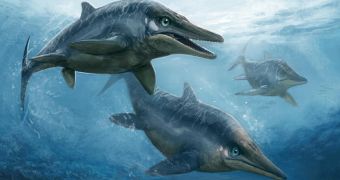As many as 46 ancient so-called fish lizards have recently emerged from beneath a melting glacier in Chile, which can only mean that, despite the effort folks put into badmouthing them, climate change and global warming do have their perks.
Not to beat about the bush, the official name for these creatures – the one that was probably inscribed in their ancient stone-carved ID and driving license – is ichthyosaurs.
Live Science tells us that these reptiles roamed the Earth about 245 million to 90 million years ago, during the Mesozoic Era, and inhabited aquatic environments.
Specifically, they were marine reptiles and were built in such ways that they were able to reach impressive speeds when swimming, scientists who have studied their remains explain.
Thus, their bodies had a shape similar to that of modern torpedoes, and they were equipped with strong vertical flippers. Their head ended with a long snout fitted with a set of scary-looking teeth.
“They look a lot like dolphins today,” study leader Wolfgang Stinnesbeck with the University of Heidelberg in Germany tells the publication in an interview. Still, chances are they weren't nearly as cute as dolphins.
Investigations have shown that the 46 fish lizards whose remains have been discovered in southern Chile belong to four different species. Of these remains, some belong to adult individuals and others to very young specimens.
Of the specimens found under the melting glacier, the biggest is estimated to have measured about 16 feet (roughly 5 meters) from head to tail when alive and swimming. The smallest are mere embryos found inside a female's tummy.
Evidence indicates that these creatures died and eventually came to be fossilized after getting caught in a series of mudslides. More precisely, researchers say that they likely got sucked into the deep sea when the mudslides occurred and then became entombed in sediment.
The fact that sediment covered their bodies shortly after death might explain why it is that, although they are very old, their remains are very well preserved and why specialists have even come across traces of soft tissue when examining their fossilized corpses.
The 46 ancient fish lizard specimens were uncovered in Chile's Torres del Paine National Park. To get to where the fossilized remains were hidings, paleontologists had to travel by car for five hours, hike for 10 to 12 hours to reach they camp, and then embark on another 2-hour-long hiking expedition to reach the digging site.

 14 DAY TRIAL //
14 DAY TRIAL //